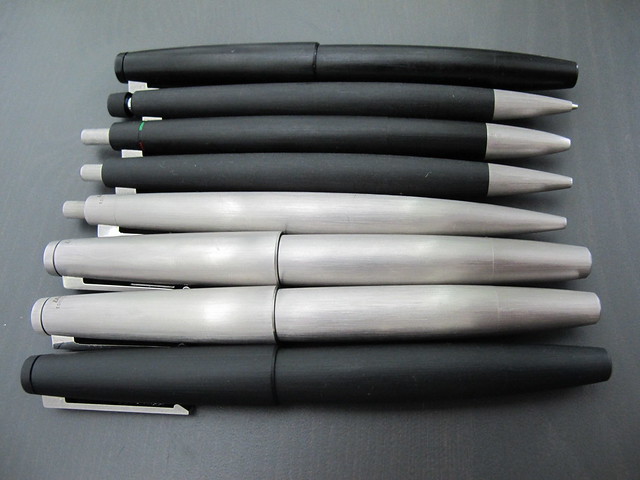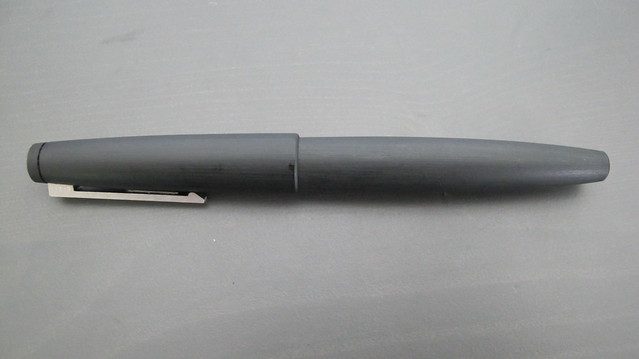Lamy 2000 and the Origins of "Lamy Design"
This work is licensed under a Creative Commons Attribution-NonCommercial-ShareAlike 3.0 Unported License by Brandon Hollingshead, August 2012, for The Fountain Pen Network and is reproduced here with permission of the author. This license extends to all text, images, and videos associated with this work.
Introduction
Lamy 2000 is one of the most recommended pens to new fountain pen users, in part because it is fairly common and relatively inexpensive; because it combines refined design sensibilities, an advanced piston mechanism for taking in and putting out ink, and a gold nib; and because the Lamy firm stands behind their product with an excellent guarantee. Yet, for all the praise it receives, Lamy 2000 is also a divisive pen. It is disparaged for its temperamental nib, its monochrome color scheme, and minute details of its design. This cannot and should not be ignored.
Because the Lamy 2000 was designed in the mid-1960s, and because Lamy has cultivated an image of design-focused production, there is a certain mystique around the pen and its "Bauhaus" sensibilities. Wishing to learn more about the firm, the pen, and the design tradition from which both emerged, I read widely and put my Lamy 2000 pens to great use in drafting my notes and this article. The result of my activity is before you.
The Lamy 2000 family, from bottom: Fountain pen, Edition 2000 Fountain Pen, 2012 Lamy 2000M fountain pen, Edition 2000 ballpoint, ballpoint, 4-in-1 ballpoint, mechanical pencil, and rollerball.
John Siracusa wrote in an essay for Ars Technica that most geeks have a hypercritical inclination "to some degree, even if it's just nitpicking logical or scientific flaws in a favorite TV show or movie. This is actually a skill worth developing…. Maybe you're afraid you don't know enough about anything to trust the validity of your criticism. Putting aside the extremely small likelihood that this is actually true, it shouldn't stop you." The tagline for Siracusa's podcast Hypercritical is "Nothing is so perfect that it cannot be complained about." In this spirit of geek obsession, I present a hypercritical review of the Lamy 2000 line of pens, warts and all. I hope that others with more information, challenges, or corrections to the information presented here will step forward for a lively conversation.
Part 1 describes the history of the Lamy company, the origins of its design focus, and the design ethos from which Lamy 2000 emerged. Part 2 extends the design review by describing the pen's construction materials and its weights and measurements. Part 3 describes the main component parts of the Lamy 2000 and some discussion on recurrent problems. Part 4 describes the steps necessary to completely take apart the Lamy 2000 fountain pen. Part 5 briefly describes each product in the Lamy 2000 line, from the ubiquitous standard fountain pen to the high-end limited edition models. The conclusion brings it all together.
Part One: Lamy company history, the origins of Lamy Design, and the ethos of Lamy 2000 style
The first member of the Lamy 2000 series, the fountain pen, was introduced in 1966, a transitional period for writing instruments in general and the Lamy firm in particular. In the mid-1960s, Lamy found itself in need of a breakout hit. Its Lamy 27 model of the mid-1950s was a success, but they sought a new product to increase sales and demonstrate to the industry that it was not a one-hit-wonder. Prior to the launch of the Lamy 2000 in 1966, Lamy was something of a forgettable pen company. Lamy's genesis is with C. Josef Lamy, a representative in Heidelberg of the Parker Pen Company. In 1930 he launched his own company to sell pens under the Orthos and Artus brands. He struggled through World War II (producing munitions and pens in the same factory), later to relaunch the company as C. Josef Lamy GmbH in 1948. Lamy’s first notable product was the Lamy 27, which was most excellently reviewed by FPN member MYU in “The Lamy 27 - Contender to the Parker 51.”
In 1962, Dr. Manfred Lamy, son of the company's founder, joined the firm as marketing manager. From the start, he worked to address the problem that Lamy lacked a consistent or distinctive design. Dr. Lamy's project was to craft a "Lamy Design" vocabulary, which took shape in development of the Lamy 2000 project (source). To do so, Lamy contracted the pen design to a leader in the industrial design space, Gerd A. Müller of the venerable Braun design powerhouse. At the time this was a risky proposition, but with the benefit of hindsight, we know that it paid off--and how. Indeed, it worked so well that a key tenet of "Lamy Design" that stands to the present is to rely on the skills and talents of key design figures, first with Müller and the Lamy 2000 (and later the CP1, ST, and Unic), then Wolfgang Fabian and the Lamy Safari/Al-Star, and up to the present with Franco Clivo and the Pico and Dialog 3 (more on Clivo in a bit). Although market research and surveys indicated the Lamy 2000 would do well with “successful, middle aged men, who were image conscious, but tended towards understatement,” Lamy was to see overwhelmingly positive responses to and demand for the new pen. The rest is history: the 2000 has been in demand since 1966, remains in continuous production, and sits as the flagship of Lamy’s lineup (source).
The Lamy 2000 represented more than just a successful product: it laid the foundation for Lamy's long-term success as a company. The company proudly boasts, “in 1966 the distinctive style of Lamy Design was born with the LAMY 2000” (source). Lamy does not offer an explanation or guiding statement of what Lamy Design actually *is*, but they do make the following claims on its corporate information website.
Let’s unpack some of these phrases, beginning with “the tradition of the Bauhaus principle of functional design” and the “form follows function” maxim that dates to Louis Sullivan's Chicago skyscrapers. I believe that in doing so we see that Lamy makes a genuine claim to its Bauhaus pedigree.Design, quality and ‘Made in Germany’ are the pillars of the Lamy corporate strategy. These are underpinned by the actively lived Lamy corporate culture.
- Customer-oriented: We focus on the needs of the customer.
- Creative: We are prepared to create change and have the courage to try something new every day.
- Cooperative: We act cooperatively internally and externally. We see ourselves as a high-performance community – based on mutual trust and respect. (source)
Highest quality in technology, processing and material is self-evident in Lamy products. Lamy writing instruments make a clear statement: ‘best value for money’ (source). Our products are self-contained and succinct. By tradition they embody the Bauhaus principle of functional design: ‘form follows function’. [Note: emphasis added] This approach makes Lamy products unmistakable style icons and the name Lamy a quintessential brand (source). Lamy writing instruments embody the best German design tradition and engineering art. They stand out by virtue of innovation, reliability, restraint and status which does not relate to luxury but to intelligence (source).
This work is licensed under a Creative Commons Attribution-NonCommercial-ShareAlike 3.0 Unported License by Brandon Hollingshead, August 2012, for The Fountain Pen Network and is reproduced here with permission of the author. This license extends to all text, images, and videos associated with this work.









 Reply With Quote
Reply With Quote
Bookmarks